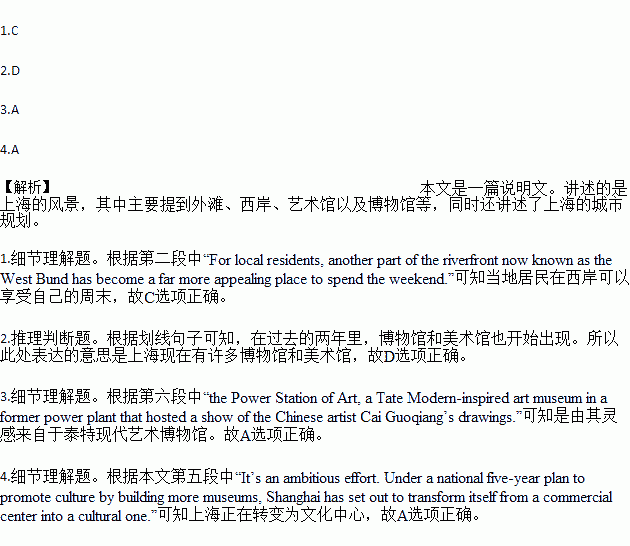题目内容
In Shanghai, the historic Bund(外滩)catches much attention---many former banks and trading houses along the Huangpu River, built a century ago in different architectural styles, are monuments to the grandeur(辉煌)of that era. It can also suffocating(令人窒息的)on weekends, with tourists struggling for taking photos.
For local residents, another part of the riverfront now known as the West Bund has become a far more appealing place to spend the weekend. Here, a once industrial area known for aircraft manufacturing(制造)has been transformed into a green corridor where local residents come to ride bikes or enjoy picnics on the grassy riverbank.
In the last two years, museums and galleries have also started popping up as part of the city’s plan to turn the West Bund into a world-class art and culture center.
On one end of the waterfront area, two huge industrial buildings have been transformed into the West Bund Art Center, site of a new annual art exhibition, and the Yuz Museum, focusing on contemporary works. On the other end is another institution exhibiting a mix of classical antiquities(古董)and modern Chinese art, called the Long Museum West Bund.
It’s an ambitious effort. Under a national five-year plan to promote culture by building more museums, Shanghai has set out to transform itself from a commercial center into a cultural one.
To achieve this, the city has built may museum buildings, including the Shanghai Natural History Museum, designed by the American architects, and the Power Station of Art, a Tate Modern-inspired art museum in a former power plant that hosted a show of the Chinese artist Cai Guoqiang’s drawings.
Across the river, two former exhibition halls from the 2010 World Expo have also been transformed into museums---the oversize glossy-red former China Exhibition Hall is the new home of the China Art Museum.
1.Why are the local residents more interested in the West Bund?
A. It attracts the world’s attention.
B. They can visit aircraft industry there.
C. They can enjoy themselves there at weekend.
D. It shows Shanghai’s grandeur int the last century.
2.What does the underlined part in Para.3 mean?
A. Museums and galleries have been transformed greatly.
B. There are many museums and galleries crowded with people.
C. Museums and galleries have taken measures to attract visitors.
D. There are many newly transformed and built museums and galleries.
3.According to the text, the Power Station of Art is _________.
A. inspired by Tate Modern
B. showing contemporary works
C. exhibiting Cai Guoqiang’s drawings
D. located in the former China Exhibitions Hall
4.What could be the best title for the text?
A. An art explosion takes Shanghai
B. The rapid development of Shanghai
C. Shanghai builds the largest exhibition hall
D. Shanghai’s leading role as a commercial center


 t do you 8.(meaning)?” Bob answered 9.(slow),"Well, when there's a party in town, it belongs to my daughter. 10. there's a football game somewhere, it belongs to my son. When I've washed it, and it looks really nice and clean, it belongs to my wife. And when it is dirty, it's mine."
t do you 8.(meaning)?” Bob answered 9.(slow),"Well, when there's a party in town, it belongs to my daughter. 10. there's a football game somewhere, it belongs to my son. When I've washed it, and it looks really nice and clean, it belongs to my wife. And when it is dirty, it's mine."